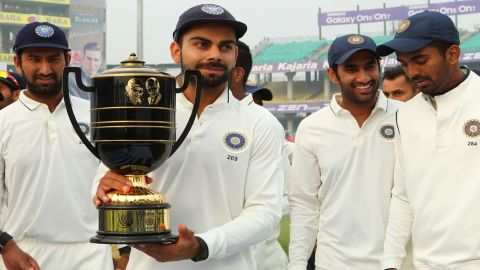Trophy was to be made for India-South Africa Test series and help was sought from jail to make it – Why so?
Cricket News Desk. When this decision was taken, BCCI President Jagmohan Dalmiya was present there and he said- 'The fight for freedom has been a common thread between these two countries. Mahatma Gandhi and Nelson Mandela used non-violence and non-cooperation as weapons to liberate countries and inspired the world to adopt it. So, Australia and England may have the Ashes, but whenever India and South Africa play a Test series, the memories of these two iconic historical figures come alive.
When it was decided that the reciprocal series would be named Gandhi-Mandela, it was about creating a trophy that would become as much a part of history as their name. For this, BCCI came up with a unique suggestion – to make the Freedom Trophy, use iron used for security purposes from the prison where Mahatma Gandhi and Nelson Mandela were imprisoned. Now both boards have joined their countries in taking on prisons – the BCCI brought in the bars of the cell in which Gandhiji was kept, while Cricket South Africa brought in the barbed wire of the prison.
By then Shashank Manohar had become the BCCI chief and he wrote a letter to Yerwada Central, where Gandhiji was imprisoned during the freedom struggle (specifically between 1930-42) and requested that two bars be removed from that cell. . Similarly, Cricket South Africa demanded a piece of barbed wire from South Africa's Robben Island prison (where Mandela was held). BCCI's letter reads – 'We want to make a unique trophy in which pieces of the bars of Yerwada jail will be used.'
Then IG Jail Bhushan Kumar Upadhyay was there and he had sought a report in this regard from Yerwada Jail officials. Then it was revealed that in the cell where Mahatma Gandhi was kept, all the things used by Gandhiji during his imprisonment were kept safe. He had already said that in such a situation it would be difficult to remove the bars from SAIL – 'SAIL has international importance and removing two bars would not look good.'

Thus, the BCCI and Cricket South Africa aimed to make the trophy unique by using historical irony with the Gandhi and Mandela connections. The Indian board was the first to admit defeat – there was no response to a request for double supplies from Pune's Yerwada prison.
While all these efforts were going on, the upcoming Mahatma Gandhi-Nelson Mandela series reached its final stages and there was no sign of a trophy. Making the trophy was the job of BCCI. No one knew what the trophy would be like? The trophy unveiling ceremony of both the captains was not even conducted before the start of the series. Even the broadcaster and the star had nothing to show for the trophy of that series. Then Gandhiji started searching for something else.
The CSA was confident that they would remove the barbed wire from the prison but ultimately they also failed. In such a situation, BCCI decided to make a special gold plated trophy to make this prestigious series memorable. Pictures of these two big personalities have been made on it.


Comments are closed.